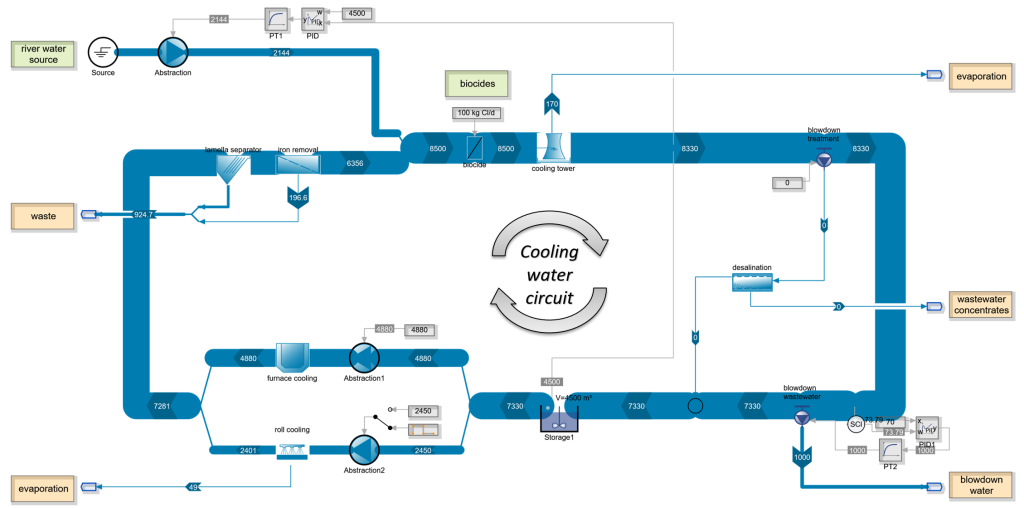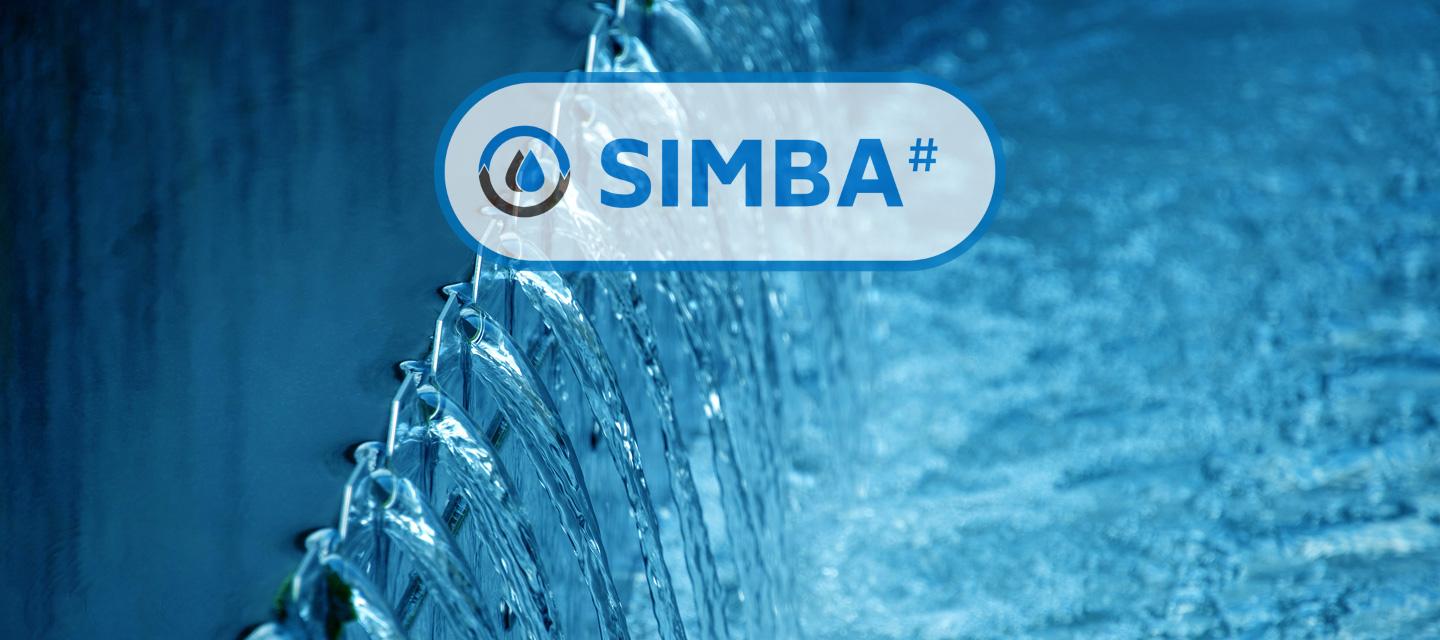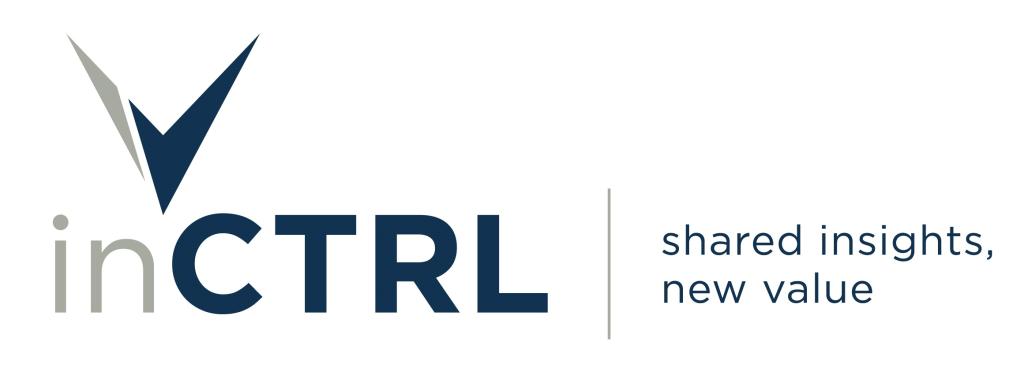The SIMBA# simulation system is a versatile software for modelling and dynamic simulation in water and wastewater engineering. It integrates activated sludge models, aeration systems, sludge digestion, sewer networks, rivers and any kind of automation solutions.
Release SIMBA# 7.0
With the new version 7, SIMBA has been built on a new technical platform. It now uses .NET 9.0 (previously .NET Framework 4.7) and Avalonia for the user interface (previously WPF).
For SIMBA users, this results in the following advantages:
- SIMBA is now technically up to date and benefits from new developments.
- Light and dark mode are available.
- In principle, SIMBA now also runs on Linux and macOS systems (corresponding installers are in preparation).
- New features in SIMBA# 7.0
-
- SCADA library: This library allows a model to be operated in real time via a SCADA interface. This enables, for example, its use in the training of plant personnel.
- Animated reaction networks: Animation of material flows in a reaction network simulated in a CSTR block, based on an ASM model in SIMBA.
- Optimization and calibration assistant
- Reporting assistant
- Dynamic text displays (Animation Block) with simulation results
- New Sankey diagram options
- Code auto-completion in editors (C#)
- Extended solar radiation model with shading (for PV)
Reaction network for an ASM3 variant in the denitrification tank
SCADA user interface for operating a wastewater treatment plant
- New features in SIMBA# 6.0
-
- E-Check Block Library: Support for energy analyses and energy checks according to the DWA A216 guideline, the library contains energy consumption models for all relevant aggregates and energy generation models and allows the description of energy balances of a wastewater treatment plant.
- Wastewater treatment plant hydraulics: Module library with the hydraulic components of wastewater treatment plants, stationary and dynamic calculation, consideration of special hydraulic situations
- Dynampere: Simplified analysis of energy concepts, mapping of energy generation and consumption as well as different energy types and energy storage systems
- Integration of AI tools: Modelling, learning and execution of Artificial Neural Networks
- Enhanced model for the elimination of trace substances: Improved models for the elimination of micropollutants with powdered activated carbon
- Digital twins: Online simulation coupled with real systems
- Additional features: New wastewater treatment plant influent model, improvements in the water chemistry library, new optimisation interface
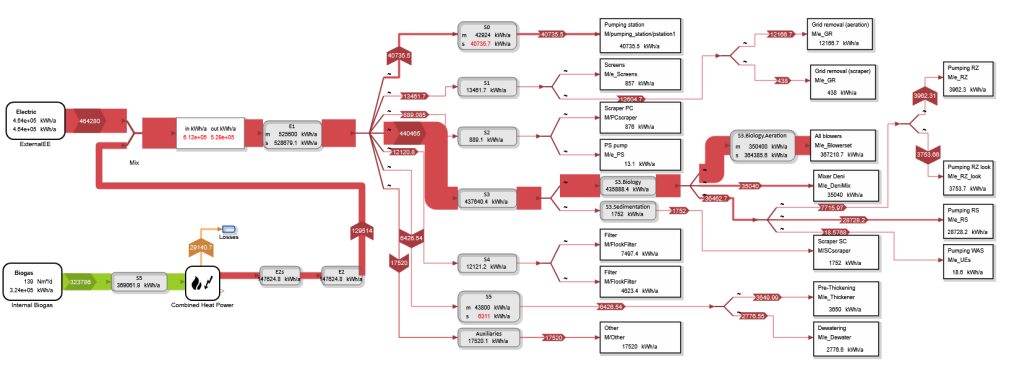
Sankey diagram of the energy flows in a wastewater treatment plant
- What is SIMBA#
-
SIMBA# is the world's leading integrated modelling and simulation platform for innovative model-based solution concepts in the water, wastewater and biogas sectors. The simultaneous modelling of a wide variety of systems (such as sewage treatment plants, sewer networks, drinking water networks, rivers and also biogas plants), including control concepts, allows an integrated view of all components, flows and material fluxes and well-founded process engineering, energy and control engineering analyses and optimisations.
In Germany and German-speaking countries, SIMBA# is widely used to support research and teaching activities in universities. From the point of view of practical application and with regard to the increasing requirements in the field of planning and operation of wastewater engineering plants, SIMBA# is being used more and more by water companies, wastewater associations and consultant engineers in Germany and beyond.
- History
-
Since its first beginnings in 1994, the SIMBA simulation tool is now being used for research and application worldwide in the field of modelling and simulation of sewage treatment plants, sewer networks, rivers and agricultural biogas plants for more than 25 years. In its early years, SIMBA was a toolbox for the software tool MATLAB/Simulink, which is widely used in science. Since 2013, SIMBA# is now a technically independent solution and is also ideally suited for applications in daily engineering practice.
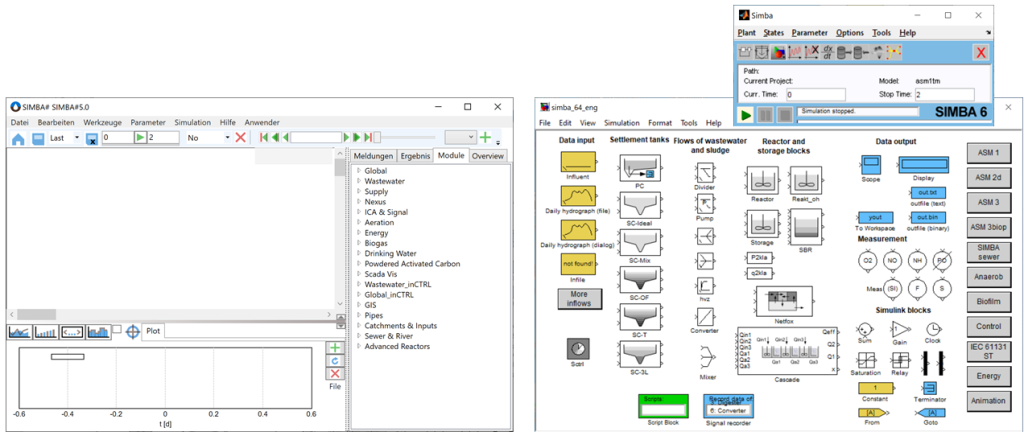
User interface and module library of SIMBA# 5.0 (left) and SIMBA (old version 6)
- Advantages of SIMBA#
-
Due to its high flexibility, SIMBA# offers a wide range of benefits. These include, among others:
- Detailed mapping of the interaction of process engineering with the mechanical equipment (e.g. the aeration system) and planned automation functions.
- Dimensioning and evaluation of wastewater treatment plants according to the DWA document T4/2016 "Dimensioning of wastewater treatment plants in warm and cold climate zones" (EXPOPLAN Tool)
- Compatible with DWA-A 131 guideline
- Inflow characterisation of municipal wastewater treatment plants based on the approach developed by the Central European researchers‘ Simulation Group (www.hsgsim.org)
- Real-time execution online for operational support with the open-source development ifakFAST (digital twin)
- Integrated consideration of sewer networks, sewage treatment plants and rivers for an immission-based analysis of urban wastewater systems
- GIS-based modelling for georeferenced representation of sewer networks, water bodies, drinking water networks, additionally representation of GIS shape files and bitmaps
- Digital elevation model (DEM) for the representation and use of elevation model information for the modelling of flows and material fluxes in supply and disposal infrastructures (e.g. sewer networks, drinking water networks)
- High flexibility and open source: use/extension of established models, development of user-specific models
- Modelling and simulation of many other processes (e.g. novel sanitation systems, industrial water systems, biogas plants)
- Modelling of interactions between liquid, gas and biofilm phases (multi-phase approach). This allows a whole range of new reactor types and processes to be modelled. The multiphase approach is particularly suitable for developing models for the treatment of industrial wastewater.
- Support for digitalisation processes (e.g. for the digitalisation of plant planning and operating processes).
- Extended Gujer process matrix editor
- Extensive functions for result evaluation
- Powerful graphical scripting tools, script execution via WEB apps
- Annual user meetings as an exchange platform with more than 25 years of tradition
- Modelling principle and model libraries
-
The structure of simulation models is based on the graphical interconnection of modules, each of which represents a process component (e.g. sewer section, primary treatment, aeration tank), to form a flow diagram.
- Activation processes in wastewater treatment (ASM1, ASM3, ASM3biop, ...)
- Biofilm processes in wastewater treatment (MBBR, FBBR, MABR, TF, Granula)
- Anaerobic degradation processes (digestion), sludge treatment
- 4th treatment stage with activated carbon (PAC), process water treatment (Anammox)
- Wastewater transport, retention and mass transfer in sewer systems (hydrological and/or hydrodynamic)
- Water flow and quality in natural flowing waters
- A wide range of control functionalities including MBPC
- aeration systems
- Pressure pipes and pumps
- Drinking water analyses
SIMBA# can be used to realise a wide range of applications in engineering practice and in research and teaching.
- Fields of application
-
- Design of wastewater treatment plants taking into account numerous process options including control
- Optimisation of process design and operation of existing wastewater treatment plants
- Analysis of runoff patterns in urban areas
- Development and testing of strategies for sewer network management or sewer network control
- Analysis of the interaction of wastewater discharge, wastewater treatment, sludge treatment and water quality in receiving water bodies
- Analysis of process water management, sludge treatment and energy consumption
- Planning of the use of "digital twins“
- Design of any biogas plant concepts including control
- Virtual commissioning of automation solutions in the water sector
- Mapping and analysis of the complex interactions of the water, energy, waste and food systems ("water-energy-food nexus")
- Wastewater treatment plants
-
With the ever-increasing requirements in the area of planning and operational management of wastewater engineering plants, SIMBA# is pursuing the goal of supporting classic design methods in these areas with the tool of simulation. For the area of wastewater treatment plants, this is expressed by a close link of the DWA A131 design guidelines with the mathematical activated sludge models ASM3 (Activated Sludge Model No. 3) and ASM3biop as well as the modules available in SIMBA# for individual process steps (e.g. denitrification, nitrification, secondary sedimentation).

Model of a wastewater treatment plant with pre-denitrification in SIMBA#
Fields of application
In the field of wastewater treatment, SIMBA# can be used, for example, as a tool to support the following tasks:
- Design of plants, processes and control concepts,
- Optimisation of process design and development of concepts for the energy management of wastewater treatment plants, and
- Development of model-based operation management concepts (observer, MBPC), which can also be used in an online version together with the open-source development ifakFAST for the operation of real plants.
Reactor and activated sludge models
A wide range of combinations of transport and reactor models and activated sludge models is available for the simulation of wastewater treatment plants. Transport and reactor models include modelling blocks for the description of an activated sludge mixture in reactors with intensive mixing and/or aeration by surface aerators and pressurised aeration systems, as well as primary and secondary clarifiers. Tank cascades and batch reactors are also available. Independently of these reactor models, it is possible to choose which activated sludge model the user wishes to work with. Such an activated sludge model defines a number of substance groups of wastewater constituents and microorganisms as well as a number of chemical and biological processes that are considered important for the respective processes.
For the description of the degradation of organic contaminants (COD) and the removal of nitrogen (nitrification/denitrification), for example, the standard models ASM1 (Activated Sludge Model No.1) and ASM3 of the IWA are available. For planning purposes, the ASM3h and ASM3bioph are available in versions of the Central European Researchers‘ Simulation University Group (HSG), which are compatible with DWA A131 2016.
Models can be freely edited or modified with an easy-to-use editor in Gujer Petersen matrix notation. The following activated sludge models are included in SIMBA# as default options:
- ASM1h – Standard model of IWA with established modifications to improve applicability, parameters according to HSG,
- ASM3h – Version of the IWA's ASM3 with parameterisation according to suggestions of HSG,
- ASM3bioph – The IWA's ASM3 with an EAWAG extension for biological P elimination,
- ASM_inCTRL – Extended model (COD, multistage nitrification/denitrification, bioP) provided by the experts of the inCTRL company,
- ASM_XL_lag – Extended model (COD, multistage nitrification/denitrification, anammox) as a project result of the NoNitriNox project (BMBF).
Model blocks for primary and secondary sedimentation
A range of models of varying complexity is available for mapping settling processes in primary and secondary sedimentation, including:
- 3-layer secondary sedimentation model with variable sludge bed compatible with DWA A131 (2016),
- Simple primary clarification model according to Otterpohl/Freund with specified COD elimination as a function of residence time,
- Ideal sedimentation tank (ideal solid/liquid separation, no storage tank),
- Ideal sedimentation tank with storage (predefinable solid/liquid separation and simple storage).
Ventilation system models
SIMBA# also includes detailed models of compressed air ventilation systems. The model library contains components for the description of blowers and blower controls, pipelines with typical installations, control valves (conventional and new developments) and aeration elements (devices for the fine-bubble introduction of air into aeration basins), which can be interconnected with each other or in connection with a process engineering wastewater treatment plant model. Of course, the function of the automation technology can also be taken into account down to the last detail.
With this extension, it is now possible to
- aeration systems can be designed more energy-efficiently,
- frequent planning errors that lead to unfavourable operating behaviour can be avoided,
- future requirements for strong load fluctuations during extreme rainfall events can be better met,
- energy procurement should be made more flexible (energy management, participation in the energy market),
- Analysing in planning terms how wastewater treatment plants can react more intelligently (Industry 4.0 concepts).
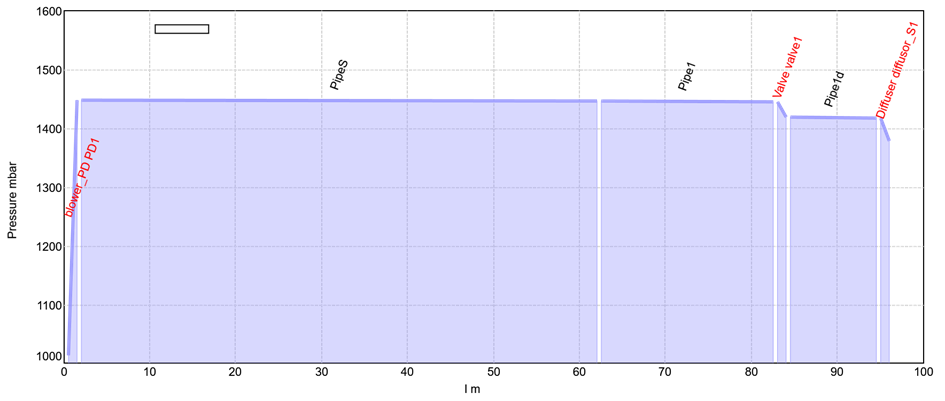
Pressure distribution in a ventilation duct
-
- Sewer networks
-
SIMBA# offers a high degree of flexibility in the selection of modelling approaches for sewer networks.
hydrological:
- Simplified conceptual modelling
- Rainfall runoff modelling
- Transport pipes in the sewer network
- Tanks and CSO structures according to DWA-A 102/A 128
- Pollution load calculation and long-term simulations
hydrodynamic:
- Complete solution of the Saint-Venant equations.
- Import of SWMM models
- Seamless integration and extension of the SWMM5 computational core (see www.epa.gov)
Any combination of both approaches:
In SIMBA#, it is also possible to simulate parts of a sewer network hydrodynamically (e.g. shallow interceptor sewers), whilst a faster hydrological approach can be used for other parts of the same sewer network (e.g. upstream catchments). This allows the complexity of a sewer network model to be set up according to the individual requirements of the respective task.
Each of the two approaches also allows:
- Specification of surface areas according to DWA A102
- Uniform and non-uniform rainfall,
- Arbitrary biochemical transformation processes in the sewers,
- Simple and complex control algorithms, including MBPC
- Analysis of the control potential according to DWA-M 180.
Overall, SIMBA# enables the seamless integration of the sewer network simulation into models of other subsystems (wastewater treatment plant, rivers).
User-friendly input and output, animation:
- User input and output, such as system definition, is graphically supported.
- Import of GIS data
- Automatic estimation of pervious and impervious areas from Copernicus satellite data
- Freely configurable evaluation routines allow quick and easy evaluation in text and image form: Sum information (precipitation, runoff and overflow volumes and loads, storage utilisation), discharge durations and frequencies.
- Rivers
-
SIMBA# also enables the simulation of flow and water quality in receiving water bodies (rivers). Any biochemical transformation models can be used here. Seamless integration into sewer network and sewage treatment plant modules as well as control algorithms are also possible here.
Discharge calculation
- hydrological discharge calculation
- hydrodynamic discharge calculation
Quality models
- Pollutant transport approaches: CSTR and Lagrange
- Biochemical transformation processes freely definable by the user in any complexity
- Predefined models (e.g. SWQM, RWQM1)
Applications
- river water quality simulation
- Analysis of discharges from the sewer system and sewage treatment plant, including evaluation according to the guideline for the analysis of ecologically critical water pollution of the German federal state of Hesse
(https://umwelt.hessen.de/umwelt-natur/wasser/gewaesserschutz/leitfaden-zum-erkennen-oekologisch-kritischer) - integrated control
- sequential and parallel integrated simulation
Lagrange modelling approach
Among the pollutant transport modelling options available within SIMBA# is the Lagrange modelling approach, which enables the modelling of transport processes without artificial errors introduced by numerical dispersion effects. The Lagrange modelling approach is based on the basic principle of "water parcels" moving along the channel. Routines for grouping and splitting these conceptual water parcels enable a perfomance-optimised simulation.
Evaluation: DWA-M 102-3/BWK-M 3-3, Urban Pollution Management Manual
New evaluation routines for water quality simulation with tabular and graphical output:
- Frequency-duration limits for oxygen and ammonium ("matrices of nine") according to DWA-M 102-3/BWK-M 3-3 and British Urban Pollution Management (UPM) Manual
- Freely configurable textual and graphical output
- Plot of longitudinal profiles
- Time-location diagrams -> Everything at a glance!
- Discharge and water quality
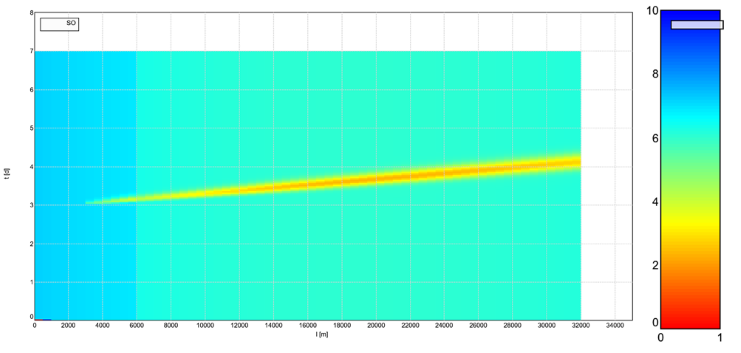
Time-location diagram: Dissolved oxygen in the water body: The effects of the CSO discharge at the location x=3000 m at time t=3d on the oxygen concentrations in the downstream water body sections are clearly visible.
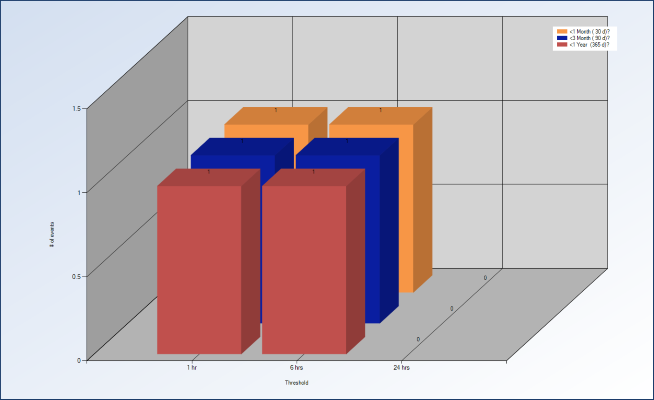
Assessment of combined sewer discharges on dissolved oxygen in the river according to recurrence-impact duration-based criteria of the Urban Pollution Management Manual
- Anaerobic processes
-
The modelling of anaerobic processes (anaerobic wastewater treatment, sewage sludge digestion) has received more attention since the ongoing demands for energetically optimal operation. The use of anaerobic models is further driven by current developments in the biogas sector. The sub-libraries digestion, Biogas and Advanced Reactors are suitable for modelling plants for anaerobic sewage sludge digestion, anaerobic wastewater treatment and anaerobic digestion of organic matter.
For this purpose the library contains:
- various anaerobic models (ADM1, Siegrist, simplified approaches),
- pre-sedimentation blocks with sludge removal,
- blocks for mechanical thickening and dewatering,
- anaerobic reactor blocks (overflow reactor, storage tank) with gas phase, UASB
- interface models for coupling with activated sludge models,
- integrated modelling of wastewater treatment and sludge treatment.
Anaerobic models enable the predictions of:
- COD, TS degradation,
- gas production/gas composition (carbon dioxide, methane, hydrogen),
- nitrogen re-solution,
- organic acids and pH value.
- Biogas plants
-
SIMBA# provides all the necessary components required for a sound analysis of wet fermentation plants. The solution includes explicit reactor models, a multi-substrate anaerobic model based on the ADM1 (Anaerobic Digestion Model No. 1 of the IWA) as well as a corresponding model for the inflowdescription. SIMBA# can be used to realise a wide range of applications in engineering practice, research and teaching. These include the design of biogas plants, processes and control concepts and the optimisation of process design. Further fields of application and features include the following:
- Design of any biogas plant concepts including control,
- Optimisation of feeding and operation management of existing biogas plants,
- Provision of different concepts for modelling measurment and control concepts (classical function blocks, Petri nets, PLC code),
- Prediction of COD, TS, oTS, NH4, N, pH, CH4, FOS, TAC (estimation),
- Convenient editors for biochecmial process models.
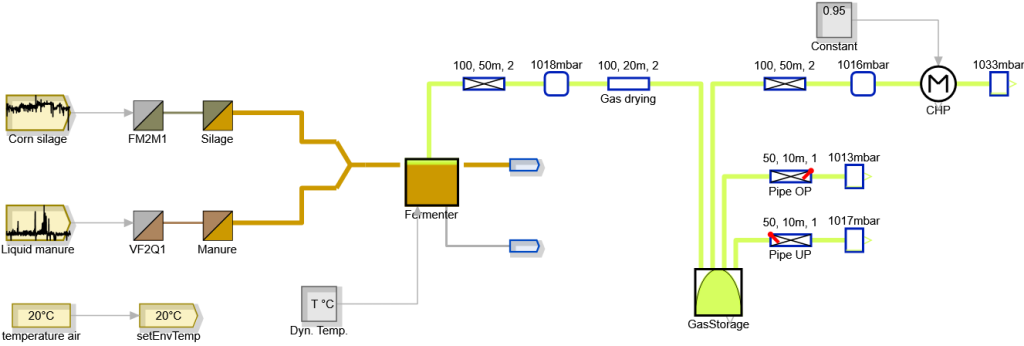
Model of a biogas plant including gas system and CHP unit
- Water-Energy-Food-Nexus
-
With the NEXUS library, SIMBA# makes it possible to create models for overall water management (e.g. reuse of rainwater and greywater), for management of supply and demand as well as for overall consideration of different infrastructure sectors (e.g. water, energy, food) and to clearly display their results as Sankey diagrams. The generation of so-called shit-flow diagrams of sanitation systems is also easily possible with SIMBA#.
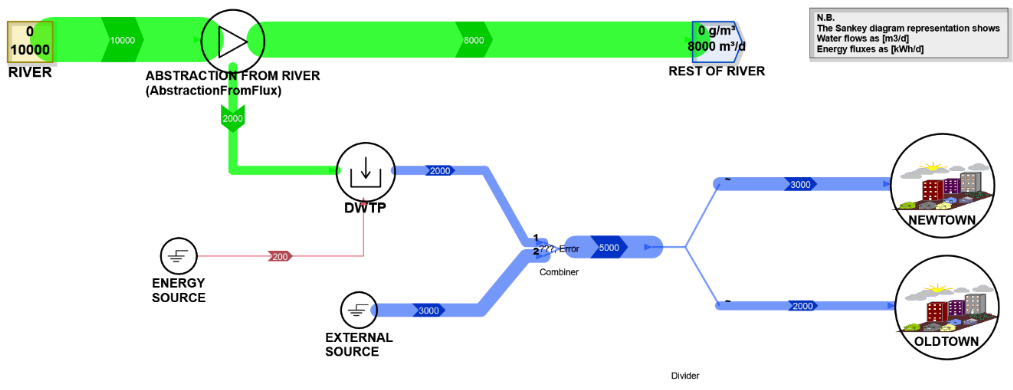
Simple example: Drinking water supply of two districts; coupling with energy demand
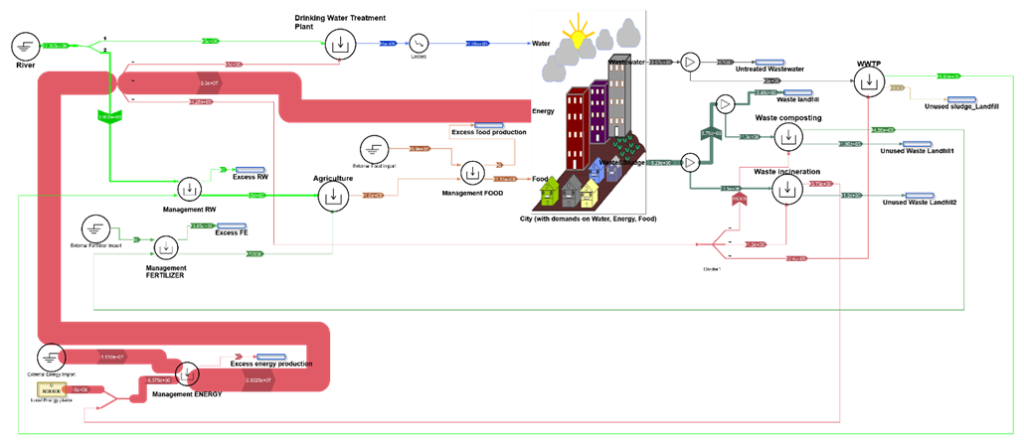
Nexus City: Material flows of the infrastructure sectors water, wastewater, energy, waste, food of an example city
- Drinking water networks
-
In SIMBA# 5.0, a new block library for modelling of pressure pipe networks was introduced. The corresponding model library can be used to simulate pressure and flow rates and mass transport in fully filled pipeline networks. This library is suitable for modelling
- drinking water networks,
- wastewater pressure pipelines,
- pumped wastewater transport in wastewater treatment plants,
- service water systems.
For the calculation of the pipeline network, a special solver is used (use of the multisolver approach), which was developed for SIMBA# based on the EPANET solver. The network calculation allows the consideration of pressure-dependent consumption (PDD) and leakages. For mass transport (advection-dispersion), either a continuously stirred tank reactor approach (cascade of CSTRs) or a Lagrangian approach can be selected. If required, also quality processes can be calculated (SIMBA ASM model).
A new diagram type has been implemented to display special longitudinal profiles (pressures).
-
- Industrial water systems
-
Due to increasing water scarcity, the reuse of industrial water and a more efficient use of material and energy resources are playing an increasingly important role in the planning and operation of industrial water systems. SIMBA# offers the possibility to simulate both the distribution and the treatment processes of industrial water and cooling water systems and to optimise their operation with regard to energy and resource consumption.
The fields of application and features include, but are not limited to, the following:
- Cooling water circuits and the balancing of heat flows,
- Accumulation of chemicals in recirculation systems and estimation of blowdown volume,
- Specific service water matrix and modelling of desalination processes,
- Generation of dynamic operating data for Life Cycle Assessment and Life Cycle Costing.
